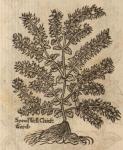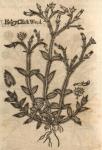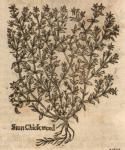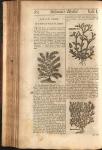Chap. 129. Of Chickweed, Bastard.


 This chapter hasn't been proofread yet.
This chapter hasn't been proofread yet.
I. The Names. It is called in Greek, *Αλπν_ X v'ah : In Latin, Alsine notha ; and in Engiifh, Bfihird Chickweed.
' II. The Kinds. There are many kinds hereof, but theie following are chief, I. Alsine foliis jub-rot units Veronica, Speedwell Chickweed. 2. Alsine folio Triffagm/s, Germander leav'd Chickweed. 7. Alsine Jpuria prior Todonjei, Alsine folio hederu-U minor, Ivy leav'd Chickweed. 4. Alsine hirfutia joins AuricuU Muris, Hairy Chickweed, with Moufe far Leaves. Alsine Viscosa, Clammy Chickweed. 6. Alsine Petrsta, Stone or Rock Chickweed. 7. Alsine ftuviatilis, River Chick-weed.
and consist of five small blew round Pointed Leaves _· which being pap away, round heads or Husks appear, in which is contained small duckweed like Seed.
III. The Descriptions. The first of these has a small and thready Roct, which perifles not in the Winter >, from whence many Branches spring up, and spread abroad, full of small and almost round Leaves, set in couples or pairs, very like to tho/e of Veronica, or Pauls Betony, called Speedwell, but not like to Elatine or Muellin of any kind. The Flowers grow at the Joints with the Leaves, from the middle of the Branches upwards, being very small, made of five blew Leaves, after which come small fiat Seed Vessels like Pouches, in which is contained small round yellowish Seed.
IV7. The second has a small long Root, Jull of many fihrcs or threads, which continue all the Winter, from which come forth several small weak Branches spreading upon the ground, three or four Inches long, Jet with small and somewhat round Leaves, which are dented about the edges, and Pointed at the ends, fariding by couples one against another : At the ' Joints thereof towards the tops, come forth small blew Flowers, and sometimes white, consisting of five round pointed Leaves s after which succeed small round Seed Vessels, two always joined together, having small round Seed within them.
V The third or Ivy leav'd Chickweed, has a small and thready Root, from whence rise up hairy tender Stalks or Branches, many of which spread themselves upon the ground, set with two Leaves at * Joint, hairy and Ivy like, but nothing fo large. De Leazrs, says Gerard, resemble the Back oj a Bee when it flies. Ihe Plowers grow at the tops,
VI. The fourth, or Hairy leav'd Chickweed, hat a very small Root, with a few Fibres at it, from which spring up several hairy Stalks or Branchesy which creep upon the ground ; upon which grow in pairs, small, long, whitish, hoary Leaves, of a A\oufe Ear like fashion : the Flowers grow at the ends of the Branches, of a bluish color, which give long and pointed Seed Vessels, in which is contained small Seed, like that of the Common Chickweed.
VII. The fifth, or Clammy Chickweed, has a small fibrous Root, from whence come Jorth Branches, which (hind more upright than the last, with rough, hairy, and clammy Leaves, somewhat like the Common Chickweeds, but of a more blewish green. The Flowers are small and white, and scarcely open themselves but in the hot time of the day, standing at tlx ' tops of the Stalks, which from the middle upwards are fo clammy, that they will stick to ones Fingers, if touched, whereby they are apt to catch Flies, and other small things which fall upon them.
Vill. The sixth, or Scone Chickweed, has a small ana thready Root, which fends forth many small and upright Branches, thick set r> which fo interfere one with another, that the whole Riant ( which ts indeed but a small Herb ) seems like unto a small Bush. The heaves are small and pointed; and the Flowers small and white, like the other Small Chickweeds. Which being past away, round Heads or Husks come forth, like unto those of Line or Flax, in which the Seed, ( which is very small) is contained.
IX. The seventh is a Bastard kind of Chickweed, growing by River sides _·, // is a very small Riant, but has an admirable thick matted Root, like a HiJ-fock, made up of a vast number of fibrous or thready firings, from whence rise up many small tender 'Branches, ft retching or trailing along the Stream, upon which grow long Leaves, having a long middle Rib, upon which grows on each side thereof a great number of other smaller Leaves, like those of Lentils, or the Wild Vetch. The Flowers grow at the tops of the Stalks, which are small and white, after which comes in husky Heads a small Seed.
X. The Places. The sixth grows on Mountains, and in Stoney and Rocky places : the seventh grows in Rivers : the others grow in Fields, as well Lilld, as Untilld, and by Way sides, &c.
XI. The Tunes. They do all Flower in Summer, some in the latter end of May and some in June and July; some earlier, and some later than others _·, and their Seed is ripe quickly after but the fourth or hairy Chickweed Flowers not till Autumn.
XII. The Qualities, Specification, Preparations, and Virtues, Authors affent to be the lame with those of the Common Chickweed, to which you are referred-, and therefore we shall fay no more of them in this place.
Botanologia, or The English Herbal, was written by William Salmon, M.D., in 1710.

 Page 218
Page 218 Page 219
Page 219